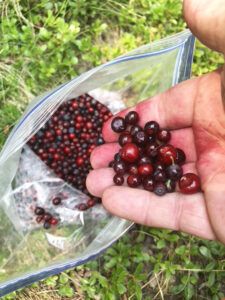
by Nathan Boddy
To many Montanans, few things are as satisfying as a pound of Montana’s hard-earned native fruit: the huckleberry. While huckleberries can be purchased, nothing makes them sweeter than stained purple fingers, mosquito bites and a sore back. Admittedly, it’s a hard decision: an afternoon playing in the perfectly warmed waters of Lake Como, or filling a bucket – one small berry at a time – all for the promise of a spectacular pancake in January. Harvesting Montana’s favorite fruit is not easy, but for many Montanans, it’s a tradition the secrets of which are as tightly guarded as elk wallows and fishing holes.
Huckleberries are native to western Montana and grow in abundance in many of the drainages feeding the Bitterroot River. They generally start to ripen mid to late July, and continue through August. Pickers who return annually to their favorite grounds can tell you that huckleberry bushes like a mix of shade and sunlight, some moisture and cool temperatures. What pickers might not know is that the plant takes five to seven years before it even starts producing Montana’s blue gold. Furthermore, the berries themselves only grow on that portion of the bush which has grown in the current year.
“Plants are vital, and they don’t get enough fans,” says Forest Botanist at the Bitterroot National Forest, Robin Taylor-Davenport, who keeps an eye on vegetation on public lands. She points out that this year’s harvest is looking somewhat different than previous years. “The weird heat and (the fact that) it’s been so dry,” are somewhat to blame. Quite simply, she says, “The berries aren’t sure what’s going on.” Taylor-Davenport points out that people have been reporting mixed results after heading out to their favorite huckleberry patch, with some ripening early, others still green on the stem, and many smaller than expected. This, combined with the heavy smoke in the air, means that pickers will have to endure a bit more for a little less harvest this year.

Taylor-Davenport also emphasizes that huckleberry plants should be dealt with carefully and respectfully. According to reports she has received, many of the huckleberry plants alongside popular trails in the Bitterroot National Forest have endured heavy activity and rough treatment, some of which may be the result of poor techniques and pickers using ‘huckleberry rakes.’ Taylor-Davenport says that the rakes, handheld devices which allow pickers to more easily separate the berries from the bushes, are often used incorrectly and can result in lasting damage to the plant. “You have to give a lot more care, and use very gentle strokes” she says, adding, “the plastic types tend to be better.” That being said, she encourages hand picking only, in order to be as gentle on the plant as possible.
Sandy Dell, of the International Huckleberry Association in Idaho, has different thoughts on huckleberry rakes, and sells them on her website. Her viewpoint is partially informed by Dr. Dan Barney of the University of Idaho, whose written statement from 2007 indicates that the devices, when “used properly, cause little or no damage to the bushes.” Of shared concern to both Dr. Barney and Robin Taylor-Davenport are the documented incidents of people cutting or uprooting entire plant colonies in order to attempt to replant them, or simply to harvest in the comfort of their own homes. Dr. Barney wrote, “I have seen formerly productive colonies damaged by people digging up the plants, apparently with the idea of transplanting them in mind. Particularly sad is the fact that, for several native species, most of the transplants will die. Container-grown (huckleberry) plants transplant easily. There is no good reason for digging wild huckleberry or bilberry bushes from public land for transplanting.”
Luckily, such acts of disregard and vandalism don’t appear to be the norm and are illegal. Joni Lubke of the Bitterroot National Forest echoes what many Montanans know, “There are so many people that are so careful about not damaging the plant or the resources around them.” That fact should assure many bountiful harvests in years to come. Lubke reminds pickers to keep an eye out for bears since, “things are drying out fast,” and the bears will be out there competing for Montana’s favorite fruit.
